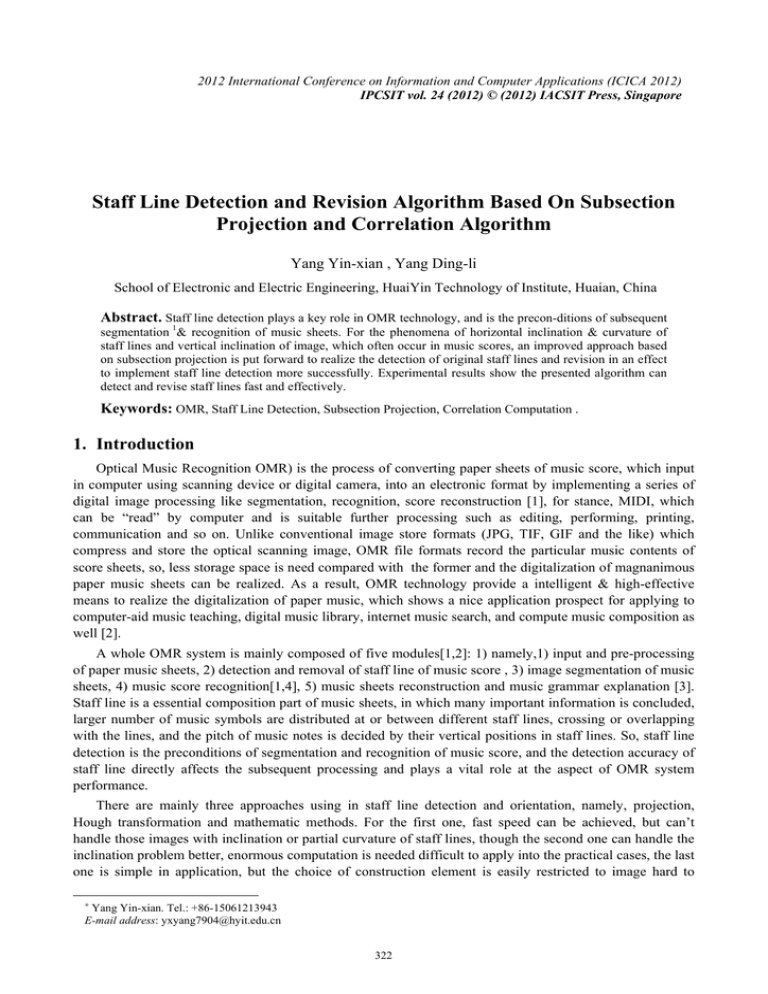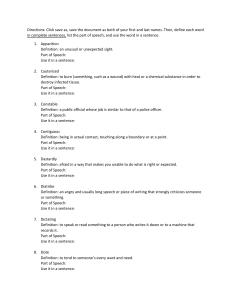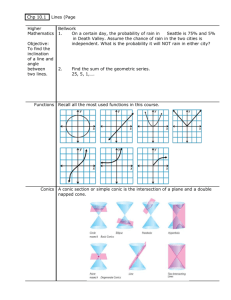Staff Line Detection and Revision Algorithm Based On Subsection Abstract.
advertisement

2012 International Conference on Information and Computer Applications (ICICA 2012) IPCSIT vol. 24 (2012) © (2012) IACSIT Press, Singapore Staff Line Detection and Revision Algorithm Based On Subsection Projection and Correlation Algorithm Yang Yin-xian , Yang Ding-li School of Electronic and Electric Engineering, HuaiYin Technology of Institute, Huaian, China Abstract. Staff line detection plays a key role in OMR technology, and is the precon-ditions of subsequent segmentation 1& recognition of music sheets. For the phenomena of horizontal inclination & curvature of staff lines and vertical inclination of image, which often occur in music scores, an improved approach based on subsection projection is put forward to realize the detection of original staff lines and revision in an effect to implement staff line detection more successfully. Experimental results show the presented algorithm can detect and revise staff lines fast and effectively. Keywords: OMR, Staff Line Detection, Subsection Projection, Correlation Computation . 1. Introduction Optical Music Recognition OMR) is the process of converting paper sheets of music score, which input in computer using scanning device or digital camera, into an electronic format by implementing a series of digital image processing like segmentation, recognition, score reconstruction [1], for stance, MIDI, which can be “read” by computer and is suitable further processing such as editing, performing, printing, communication and so on. Unlike conventional image store formats (JPG, TIF, GIF and the like) which compress and store the optical scanning image, OMR file formats record the particular music contents of score sheets, so, less storage space is need compared with the former and the digitalization of magnanimous paper music sheets can be realized. As a result, OMR technology provide a intelligent & high-effective means to realize the digitalization of paper music, which shows a nice application prospect for applying to computer-aid music teaching, digital music library, internet music search, and compute music composition as well [2]. A whole OMR system is mainly composed of five modules[1,2]: 1) namely,1) input and pre-processing of paper music sheets, 2) detection and removal of staff line of music score , 3) image segmentation of music sheets, 4) music score recognition[1,4], 5) music sheets reconstruction and music grammar explanation [3]. Staff line is a essential composition part of music sheets, in which many important information is concluded, larger number of music symbols are distributed at or between different staff lines, crossing or overlapping with the lines, and the pitch of music notes is decided by their vertical positions in staff lines. So, staff line detection is the preconditions of segmentation and recognition of music score, and the detection accuracy of staff line directly affects the subsequent processing and plays a vital role at the aspect of OMR system performance. There are mainly three approaches using in staff line detection and orientation, namely, projection, Hough transformation and mathematic methods. For the first one, fast speed can be achieved, but can’t handle those images with inclination or partial curvature of staff lines, though the second one can handle the inclination problem better, enormous computation is needed difficult to apply into the practical cases, the last one is simple in application, but the choice of construction element is easily restricted to image hard to + Yang Yin-xian. Tel.: +86-15061213943 E-mail address: yxyang7904@hyit.edu.cn 322 decide and can’t be suitable to the detection of oblique line. However, inclination or curvature phenomenon often occurs in the process of paper music score into computer, so, an algorithm based on subsection projection and correlation is put forward to realize the detection & orientation of inclination & curvature of staff lines and gain the inclination degree of image fast and effectively, sequentially, according to the results to realize revision for staff lines or image in an effect to execute the following staff line removal better. 2. Algorithm Description Conditional projection approach is difficult to distinguish staff lines when inclination& curvature of staff lines and inclination of image occur. But after careful analysis for the projection of image, such rule can be found, if image is divided into many sections along horizontal direction, then staff lines of each image section can be acted as a straight line or diagonal line approximately, so, an algorithm based on subsection projection and Correlation is put forward to implement the detection and revision operation of inclination and curvature for image or staff lines, Set the binary image after filtering, denoising, format as B(x, y),(0 ≤ x ≤ W;0 ≤ y ≤ H ) B(x, y) = 0, when pixel is black, else B( x, y) = 1. transforming on prime image Where W , H denote width and height of image respectively. Then the algorithm is described in detail as follows: 1) Image inclination revision. Because of different resolution ratio for different music image, pixel doesn’t be adopted as reference but the space between staff lines, so, firstly, staff line space of music image should be calculated as S ,namely, the length of vertical white run-length which occurrence rate is the highest in the image, secondly, along horizontal direction, part the image into N bar areas recorded as Z 1 , Z 2 , Z n , N = C e il (W /( 4 × S ) ) ,where, C e i l is towards ∞ , the width w of the first N − 1 areas, is equal to 4 × S ,else W − ( N − 1) × 4 × S , finally, implement the operation of horizontal projection for the sub-images of the last two areas, projection array can be obtained: Pr ojv [ y ] = W ∑ B( y, k ) k = ( N − 2 ) × 4 × S +1 ,1 ≤ y ≤ H 2.1 2) According to the projection array, the row positions of the first and the last staff line can be getted as along staff line positions, in the first region Z1(x, y):(N − 2) × w ≺ x ≤ W, row1− S ≤ y ≤ row1+ S ,and the second Z 2( x, y ) : ( N − 2) × w ≺ x ≤ W , row2 − S ≤ y ≤ row2 + S ,search out the biggest column value of black pixels as col1 and col 2 ,according to those values, the vertical inclination degree and length can be calculated respectively as, φ :φ = arctan((row2−row1)/(col2−col1)) , q: q = (col2 − col1) ×W /(row2 − row1) ,then the image inclination can be acquired, and the revised formula of image is described as follows: row1 and row2 ,then B '( x, y ) = B( x, y + Δ ' ) , 2.2 ' Where Δ = f l o o r ( q × x / H ) , 1 ≤ x ≤ W , 1 ≤ y ≤ H ,is the revision value for different pixels in vertical direction, B '( x , y ) is the image after revision, flo o r is the operation towards zero. 3) Inclination & curvature revision of staff lines. By implementing the horizontal projection operation for each region divided according to step one, horizontal projection array of each bar region is acquired as: Pr oj[ y, n] = k = sp + w ∑ B( y, k ) k = sp 2.3 Where sp = ( n − 1) × w ,1 ≤ n ≤ N ,1 ≤ y ≤ H , n is the label number of area. 4) According to correlation principle ,the correlation rate of two same curves is the biggest, so by implementing the correlation operation on the horizontal projections of the two adjective segments, can be acquired, further to obtain the position deviation d ( n ) between correlation array C ro ss ( λ , n ) correspondent staff lines in the two projections 323 Cross (λ , n) = P2 ∑ Pr oj (k , n) × Pr oj (k + λ , n + 1) 2.4 k = P1 where − S ≺ λ ≺ S , 1 ≤ n ≤ N − 1 , P 1, P 2 is the upper or latter value of correlation computation, if 0 then P 1 = 1 , P 2 = H − λ , λ is the moving distance of λ ≤ 0 ,then P 1 = − λ + 1 , P 2 = H , if λ horizontal projection array in vertical direction, which is setted less a staff line space, because staff line graph is a quasi-periodic graph(here, period is setted as S),if the value doesn’t set, more than one maximum can be arise. Then, find λ ( n ),1 ≤ n ≤ N − 1 corresponding to the maximum value of each correlation array, Which is the offset of the staff line of adjective graph slices in the horizontal location d ( n ) . d (n) = λ (n + 1) − λ (n) 2.5 Where 1 ≤ n ≤ N − 1 . Because the last section width is often narrow and has the same inclination degree with the former one, so the offset of the last region is setted as d ( N ) = d ( N − 1 ) to facilitate the revision of staff lines. 5) According to the offset of each region, d ( n ) , from the left to the right horizontal inclination or curvature operation is implemented, formula is as follows: N J(n) = ∑d(k −1),2 ≤ n ≤ N k=2 , J (1) = 0 Δ = floor (( x % w ) / w × d ( n )) − J ( n ) B ''( x, y ) = B '( x + Δ, y ) 2.6 where , 1 ≤ x ≤ W , 1 ≤ y ≤ H . floor denotes rounding towards zero, % denotes remainder operation, J ( n ) , 1 ≤ n ≤ N and Δ denotes accumulated deviation of each area, deviation of different pixel at horizontal direction respectively, B '( x , y ) is the image after inclination revision, B ''( x , y ) is the image after final revision. 3. Experimental Results and Analysis Fig 1 is a typical music score with image inclination and horizontal inclination and curvature of staff lines, according to the advanced approach, the image after inclination revision is shown as Fig. 2, obviously, Fig. 1 a original image of music score revision object expected is realized. Next, the horizontal inclination and curvature revision of staff lines are implemented, firstly, horizontal subsection projection is executed and the result is shown as Fig. 3, secondly, Fig. 2 the image after inclination revision Fig. 3 horizontal projection of each section according to the projection results, correlation value of adjective segment should be calculated, finally, according to the deviation of each segment projection in vertical direction, horizontal inclination & curvature revision are all be implemented, and the image after revising and the horizontal projection are shown as Fig.4(a),(b) respectively. According to Fig. 4, staff line positions can be extracted easily. Experiment results 324 Fig. 4(a),image after horizontal revision Fig.4(b) horizontal projection after revision prove the advanced algorithm can realize inclination revision effectively, furthermore, because of calculating the correlation of adjective segments for each segment in horizontal direction, bigger inclination and curvature revision can also be realized. For the convenience of sequent staff line removal, eliminating operation for pixel overlapping problem of binary image because of inclination can further implemented according to Fig.4. Fig 5 (a),(b)is the staff line image and corresponding horizontal projection after further processing and revision respectively, but how to better revise the superposing problem for partial segments still need to further research. Fig. 5(a) music image after revision Fig. 5(b)horizontal projection of music image after revision. 4. Conclusions Staff line detection or orientation is the precondition of segmentation and recognition of music symbols, for non-ideal cases of music image which often occur in the process of inputting paper music scores into computer, an algorithm based on subsection projection and correlation is put forward, which can realize the detection not only for inclination & curvature of staff lines in horizontal direct but also inclination of music scores, and further to revise staff lines and image, mainly by implementing correlation calculation for the projections of adjacent paragraphs progressively to achieve vertical deviation for each segment. Experience results show the validity and practicality of the presented algorithm and realize the detection object fast and effectively. 5. References [1] Ng, K.C. Boyle, R.D: Recognition and reconstruction of primitives in music scores .Image and Vision Computing. Vol. 14, No. 1(1996), p. 39-46 [2] Rebelo, A. Capela, G, Jaime S: Optical recognition of music symbols, International Journal on Document Analysis and Recognition. Vol. 13, No.1(2010), p. 19-31 [3] Vieira, P. Rovisco, Pais, Pinto, J.C: Recognition of musical symbols in ancient manuscripts. IEEE International Conference on Image Processing. Vol. 3(2001), p. 38-41 [4] Kobayakawa, Tatsu: Auto music score recognizing system. Proceedings of SPIE - The International Society for Optical Engineering. Vol. 1906(1993), p. 112-123 325




